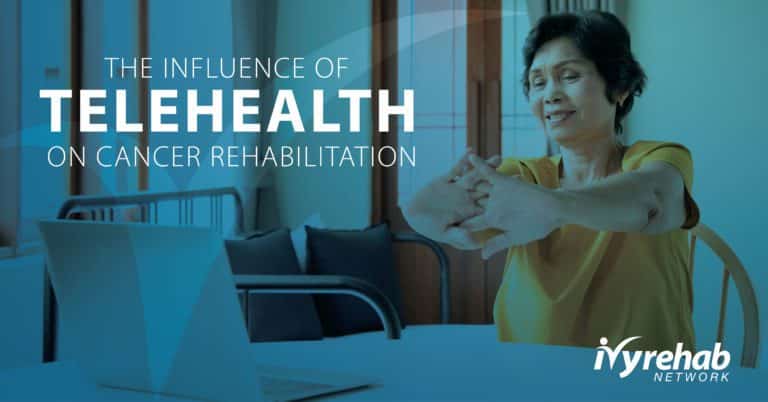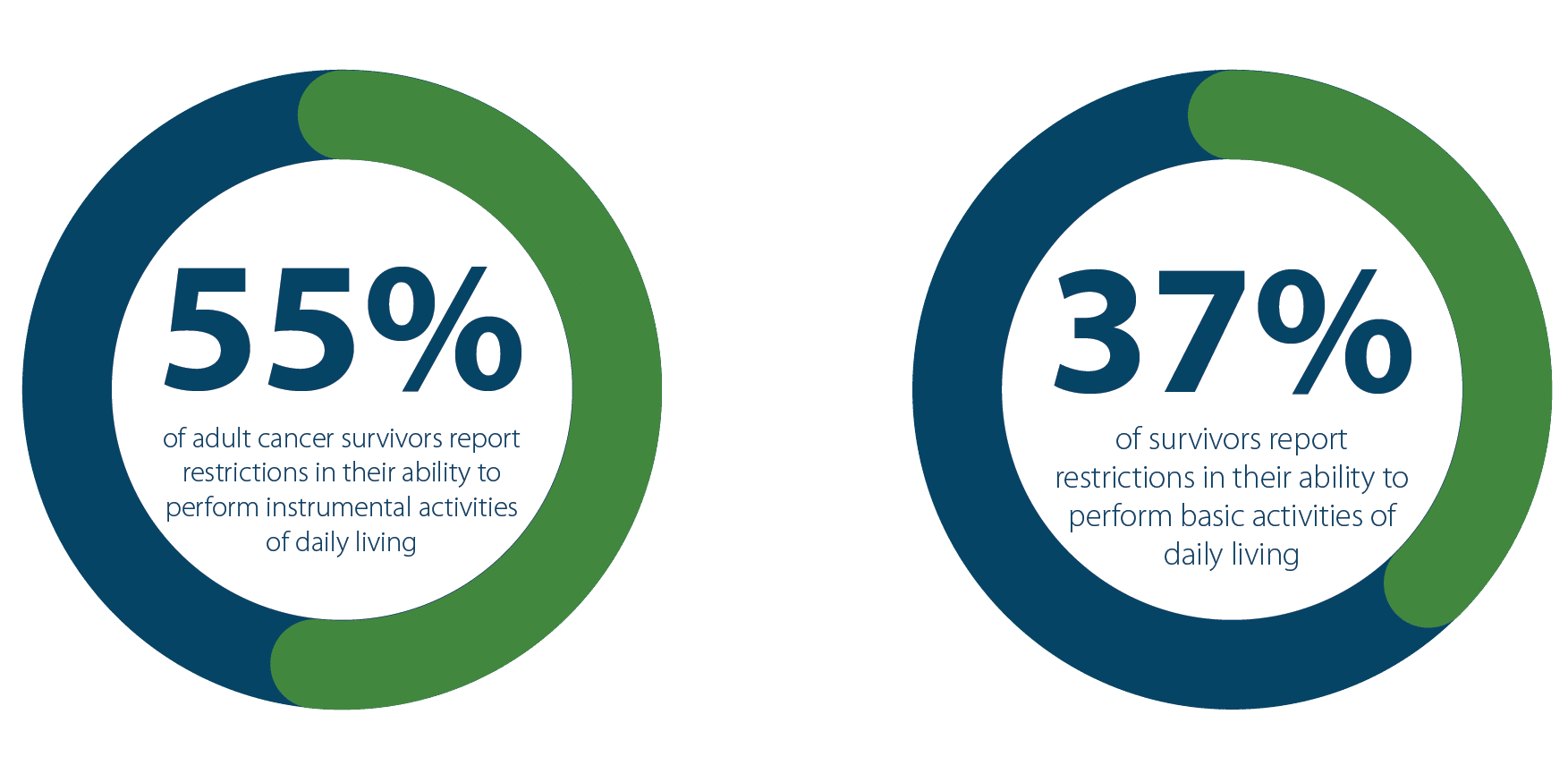
How Does Telehealth Influence Cancer Rehabilitation Interventions on Disability?
Dr. Tim Marshall, Ph.D., M.S., ACSM-CET is the Director of Clinical Outcomes & Research at Ivy Rehab Network. He is also on the ACRM Cancer Rehab Networking Group Executive committee and is the co-chair of the CRNG Research & Outcomes Task Force. He has dedicated the majority of his career to oncology rehabilitation, including extensive research on the role that exercise and rehabilitation play in reducing cancer treatment-related side effects and improving function and quality of life outcomes. His position on the American Congress of Rehabilitation Medicine (ACRM) Cancer Rehab Networking Group Executive Committee allowed him the opportunity to collaborate with a group of leading cancer research and oncology professionals. Together they published a piece with the Journal of Cancer Survivorship titled “The Influence of Telehealth Based Cancer Rehabilitation Interventions on disability: a systematic review.”
A person living with a history of cancer often experiences a variety of side effects from their cancer treatments.
Cancer treatment-related side effects can negatively impact a person’s physical and emotional health, which can make it difficult to complete tasks of daily living. Fatigue, nausea, physical weakness, and a compromised immune system can be a barrier for a survivor of cancer to seeing a rehabilitation and/or exercise professional in person for support with improving their physical and emotional health. The advent of telehealth may help overcome cancer treatment-related barriers to engaging in these services by bringing rehabilitation and exercise interventions to the patients in their home but how beneficial are the results when it comes to cancer-related disability?
Over the course of three years, Dr. Marshall, and the team from the Research & Outcomes Task force of the ACRM Cancer Rehab Network Group reviewed dozens of published articles that revolved around using digital health technology to delivery rehabilitation and exercise interventions. The team set out to understand how telehealth-based cancer rehabilitation interventions were being characterized and the effectiveness of telehealth interventions for reducing disability.

According to their study, nearly 55% of adult cancer survivors report restrictions in their ability to perform instrumental activities of daily living, and 37% report restrictions in their ability to perform basic activities of daily living.
Survivors of cancer also expressed significant challenges in returning to employment due to functional limitations. Early forms of telehealth involved limited technology. Telehealth became immensely popular throughout the pandemic, but it’s critical to note that the literature referenced in the ACRM team’s research was published between 1994 and 2020 – which was before the COVID-19 pandemic and the accelerated advancement in digital health technology and use.
“We were a little ahead of our time because we started this project before the pandemic, but the pandemic popularized telehealth because, for a while, it was the only way a patient could engage with their provider,” explains Dr. Marshall. “Most of the articles we reviewed and included in this study were published pre-pandemic, so the telehealth interventions were simplistic, meaning most telehealth interactions were through phone calls or texts. The COVID-19 pandemic accelerated the advancement of telerehab modalities. Today, we see telerehab delivered through more advanced and sophisticated ways such as smartphone apps that use video monitoring to provide immediate feedback on the ‘correctness’ and completeness of the exercise performed. We did not see these types of telerehab in the studies we reviewed.”
The participants included in the studies reviewed by the team varied in age, cancer type, the timing of treatments, and the type of treatment they were receiving, but they all had one thing in common – telehealth as part of their treatment plan. “The biggest surprise to me was the simplicity of the telerehab technology deployed in the research studies we reviewed. Even though the video was available, most telerehab services were delivered through text messages and phone calls,” said Dr. Marshall. Despite the technological limits and basic ways of delivering telehealth, the results were very promising for oncology patients.
Despite the technological limits and basic ways of delivering telehealth, oncology patients’ results were very promising. “A silver lining to the pandemic is that it accelerated the advancement of telehealth technology and the thinking around how to include telerehab into a plan of care,” explains Dr. Marshall.” In the past, survivors of cancer were required to visit a clinic in person to engage in exercise and/or rehabilitation services. If they weren’t feeling well due to their treatments or were unable to drive themselves, the visit, and thus, the treatment was missed. So telerehab provides the patient and clinician the opportunity to augment the plan of care and substitute an in-person visit with a telerehab visit-this way, the patient does not have to miss a session.”
How can physical therapy and exercise help someone who is recovering from cancer?
Physical and occupational therapists, as well as exercise professionals, are important members of a cancer survivor’s health care team because they help restore physical deficits lost during cancer treatment. Restoring these deficits is critical for a survivor of cancer to regain lost function and participate in activities of daily living. Physical and Occupational therapists can help patients during any point of their cancer journey, providing them with the tools and knowledge needed to manage their pain and fatigue and maintain their strength and activity levels.
How will this impact the future of cancer rehabilitation?
Our article provides key insights into the current state of research regarding the type of telehealth services deployed and their effect on reducing a cancer survivor’s disability. Our work, as well as the recent advancement of telehealth technology, opens the possibility for clinicians to consider using or including telerehab when an in-person visit is not possible. Given the advancement of telerehab services during and post-pandemic, we recognize that this study needs to be repeated, including only studies published post-pandemic. It would be interesting to see the effect more advanced telerehab methods have on reducing disability and improving function for persons with a history of cancer. It’s exciting to think about the possibilities!
For Dr. Marshall and the team at ACRM, this is just the beginning. Their findings indicate a positive impact on improving disability for cancer patients that merits further evaluation and study. They’d like to see a follow-up that takes a more advanced look at the role telehealth has played through today’s technology and regarding primary outcomes for survivors of cancer.

“The questions are there; it is our mission to build the evidence.” – The influence of telehealth-based cancer rehabilitation interventions on disability: a systematic review.
Dr. Tim Marshall, Ph.D., M.S., ACSM-CET, is the Director of Clinical Outcomes & Research at Ivy Rehab Network. He is also on the ACRM Cancer Rehab Networking Group Executive committee and is the co-chair of the CRNG Research & Outcomes Task Force.
Is telehealth right for you?
Nearly any rehabilitation treatment can be performed through telehealth capabilities. This cutting-edge technology will allow an experienced therapist to treat you virtually so you achieve your goals. In this virtual environment, clinicians will educate and give you the exercises and training you need to improve your current state and reduce pain. This patient-centered program is all about you; you’ll be empowered and trained by a professional therapist who will give you the activities and strategies you may need to do the exercises properly. Through the secure video call system, they will be able to provide monitoring and evaluation to ensure a quality experience that allows you to feel better, faster with long-term results. To learn more about this state-of-the-art technology, click here.
The medical information contained herein is provided as an information resource only, and does not substitute professional medical advice or consultation with healthcare professionals. This information is not intended to be patient education, does not create any patient-provider relationship, and should not be used as a substitute for professional diagnosis, treatment or medical advice. Please consult with your healthcare provider before making any healthcare decisions or for guidance about a specific medical condition. If you think you have a medical emergency, call your doctor or 911 immediately. IvyRehab Network, Inc. disclaims any and all responsibility, and shall have no liability, for any damages, loss, injury or liability whatsoever suffered as a result of your reliance on the information contained herein.